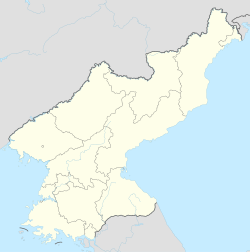µ£āÕ»¦ķøåõĖŁńć¤
µ£āÕ»¦ķøåõĖŁńć¤Õ£©ÕīŚķ¤ōńÜäõĮŹńĮ« µ£āÕ»¦ķøåõĖŁń椒╝łµ£Øķ▓£Ķ»Ł’╝ÜĒÜīļĀ╣ ņĀĢņ╣śļ▓öņłśņÜ®ņåī’╝ŵ£āÕ»¦µö┐µ▓╗ńŖ»µöČÕ«╣µēĆ’╝ē’╝īÕÅłń©▒ŃĆī22ĶÖ¤ń椵ł┐ŃĆŹ’╝īµś»µ£Øķ««ńö©õĮ£ķŚ£µŖ╝µö┐µ▓╗ńŖ»ńÜäķøåõĖŁńć¤õ╣ŗõĖĆ’╝īõĮŹµ¢╝µ£Øķ««µØ▒ÕīŚķā©õĖŁµ£ØķéŖÕóāķÖäĶ┐æńÜäµ£āÕ»¦ÕĖéÕ▒▒Ķ░ĘŃĆéÕż¦ń┤äÕŻի╣ń║│õ║öõĖćõ║║Õŗ×µö╣ŃĆé Ķ®▓ķøåõĖŁńć¤ÕĘ▓µ¢╝2012Õ╣┤ÕŠīķŚ£ķ¢ē’╝īńÉåńö▒µś»µ£āÕ»¦ķøåõĖŁńć¤Õż¬µÄźĶ┐æõĖŁÕ£ŗÕÆīõ┐äńŠģµ¢»ńÜäķéŖÕóāÕ£¢ÕĆæµ▒¤’╝īńé║ķś▓µŁóńŖ»õ║║ķĆāķøóµ£Øķ««µĢģķŚ£ķ¢ēõ╣ŗŃĆé ń░ĪĶ┐░õ╝ÜÕ«üķøåõĖŁĶÉźõ║Ä1965Õ╣┤Õ£©µ£Øķ▓£ÕÆĖķĢ£ÕīŚķüōńÜäõ╝ÜÕ«üÕĖéõ┐«Õ╗║’╝ī80ŃĆü90Õ╣┤õ╗ŻÕÅłµē®Õ╗║Õł░õ╝ÜÕ«üÕĖéńÜäõ╗▓Õ│░’╝łµ£Øķ▓£Ķ»Ł’╝Üņżæļ┤ē’╝ēŃĆéÕ£©90Õ╣┤õ╗Ż[1]’╝īĶ»źķøåõĖŁĶÉźµēĆÕģ│µŖ╝ńÜäńŖ»õ║║õ║║µĢ░µĆźÕē¦Õó×ÕŖĀ’╝īĶĆīÕĮōµŚČÕÆĖķĢ£ÕīŚķüōńÜäÕģČõ╗¢õĖēõĖ¬ķøåõĖŁĶÉźÕĘ▓ń╗ÅÕģ│ķŚŁ’╝īÕģČńŖ»õ║║Ķó½ĶĮ¼ń¦╗Õł░õ║åĶ┐ÖµēĆķøåõĖŁĶÉźŃĆé[2]ĶĆīĶó½Õģ│µŖ╝Ķ┐øµØźńÜäõ║║Õż¦ÕżÜµĢĖµś»ÕøĀńé║µē╣Ķ®Ģµ£Øķ««Õŗ×ÕŗĢķ╗©µł¢ķĀśÕ░Äõ║║ķćæµŁŻµŚźĶĆīÕøĀĶ©ĆńŹ▓ńĮ¬ńÜä’╝īõ╗źÕÅŖĶó½µ¢ŁÕ«ÜÕ£©µö┐µ▓╗õĖŖõĖŹÕÅ»ķØĀńÜä’╝łÕ”éķ¤ōµł░Õø×Õ£ŗµł░õ┐śŃĆüÕ¤║ńØŻÕŠÆŃĆüՊ׵Śźµ£¼Õø×µĄüÕāæµ░æ’╝ēŃĆéķøåõĖŁńć¤ÕÉīµÖéõ║”µÄźµöČĶä½ÕīŚĶĆģńÜäÕ«ČÕ▒¼µł¢ÕÅŚńēĮķĆŻõ║║ÕŻ½’╝īńö▒Õż¦ń┤ä1000ÕÉŹĶŁ”ĶĪøÕÆī500Ķć│600ÕÉŹĶĪīµö┐õ║║ÕæśĶ┐øĶĪīµÄ¦ÕłČŃĆé Õåģķā©ńÄ»ÕóāµŹ«ŃĆŖµ£Øķ▓£µ£łÕłŖŃĆŗµŖźķüō’╝īµøŠń╗ÅÕ£©õ╝ÜÕ«üķøåõĖŁĶÉźÕĘźõĮ£ńÜäńŗ▒ÕŹÆÕ«ēµśÄÕō▓ĶĪ©ńż║’╝īķøåõĖŁĶÉźÕåģķā©ńÜäńö¤µ┤╗ńÄ»Õóāµ×üÕģȵüČÕŖŻ’╝īńöÜĶć│Õ©üĶāüńö¤ÕæĮ[3]ŃĆéõ╗¢Õø×Õ┐å’╝īÕłØµ¼ĪÕł░Ķ┐ÖõĖ¬ķøåõĖŁĶÉźµŚČµä¤Õł░õĖĆń¦ŹķÜŠõ╗źÕÉŹńŖČńÜäķ£ćµāŖ’╝ÜĶ┐ÖķćīńÜäńŖ»õ║║Õ░▒ÕźĮÕāŵś»ķ¬©ńś”Õ”éµØÉŃĆüĶĪŻĶĪ½Ķż┤ĶżøńÜäķ¬Ęķ½ģÕÆīĶÖ½Ķ▒Ė[4][5]ŃĆéĶ┐ÖÕÉŹńŗ▒ÕŹÆõ╝░Ķ«Ī’╝īńŗ▒õĖŁÕż¦ń║”µ£ē30%ńÜäńŖ»õ║║ķāĮµøŠĶó½Õ«×µ¢ĮķģĘÕłæÕÆīĶÖÉÕŠģ’╝īÕ”éÕē▓ĶĆ│µ£ĄŃĆüńóŠńóÄń£╝ńÉāŃĆüµÄÅń®║ķ╝╗Ķģö’╝īĶ┐śµ£ēĶó½ķ×ŁÕŁÉµł¢ÕłæÕģʵŖĮµēōĶĆīÕ£©ĶäĖõĖŖńĢÖõĖŗńÜäń¢żńŚĢŃĆéĶ┐śµ£ēÕż¦ń║”2,000ÕÉŹńŖ»õ║║Ķó½µł¬Ķéó’╝īõĮåÕ░▒ń«Śµś»µØĄµŗɵآńÜ䵫ŗń¢Šõ║║õ╣¤Õ┐ģķĪ╗ÕÅéÕŖĀÕŖ│ÕŖ©[6]ŃĆéķøåõĖŁĶÉźµ»ÅµŚźõ╝Üń╗Öµ»ÅÕÉŹńŖ»õ║║ÕÅæµöŠ180ÕģŗńÜäĶ░Ęńē®’╝īõĮåÕćĀõ╣ÄÕÉāõĖŹÕł░Ķö¼µ×£ÕÆīĶéēń▒╗ķŻ¤Õōü[7]’╝īĶĆīĶéēķŻ¤ńÜäÕö»õĖĆµØźµ║Éń½¤µś»Õ£©ńŗ▒õĖŁÕć║µ▓ĪńÜäĶĆüķ╝ĀŃĆüĶøćÕÆīńÖ×ĶøżĶ¤å[4][8]ŃĆéµ»ÅÕ╣┤ń║”µ£ē1,500Õł░2,000õ║║õ╝ÜÕøĀõĖ║ĶÉźÕģ╗õĖŹĶē»’╝īÕÖ©Õ«śĶĪ░ń½ŁĶĆīµŁ╗õ║Ī’╝īÕģČõĖŁÕż¦ÕżÜµĢ░µś»Õ░æÕ╣┤Õä┐ń½ź’╝īõĮåÕøÜńŖ»µĆ╗õ║║µĢ░µś»õ┐صīüõĖŹÕÅśńÜäŃĆéµ»ÅÕ╣┤µ£Øķ▓£ÕĮōÕ▒Ćõ╝ÜķĆüµØźń║”1,500Õł░2,000ÕÉŹÕøÜńŖ»µØźĶ┐Öķćīµ£ŹÕłæ[9]ŃĆéķøåõĖŁĶÉźķćī’╝īÕä┐ń½źÕŬĶāĮµÄźÕÅŚµ£ĆÕ¤║ńĪĆńÜäµĢÖĶé▓[10]’╝īÕģŁÕ▓üÕÉÄÕ░▒õ╝ÜĶó½Õ«ēµÄÆõ╗╗ÕŖĪÕ╝ĆÕ¦ŗÕŖ│ÕŖ©’╝īÕ”éÕł░ńö░ķćīµöČĶÅ£’╝īń╗ÖĶ░Ęńē®ÕēźÕŻ│’╝īµÖÆń©╗ń▒│ńŁē’╝īõĮåµś»ĶÄĘÕŠŚńÜäķŻ¤ńē®ÕŠłÕ░æ’╝īµ»ÅÕż®ÕŬµ£ēń║”180Õģŗ’╝īĶ┐ÖÕ»╣µłÉķĢʵ£¤õĖŁńÜäÕä┐ń½źµØźĶ»┤Ķ┐£Ķ┐£õĖŹÕż¤ŃĆéÕøĀµŁż’╝īÕŠłÕżÜÕä┐ń½źķāĮµ┤╗õĖŹĶ┐ć10Õ▓ü[11]ŃĆéÕ╣┤ķĢ┐ńÜäńŖ»õ║║ÕÆīÕģČõ╗¢õ║║õĖƵĀʵ»ÅÕż®ķāĮõ╝ÜÕüÜÕÉīµĀĘÕ╝║Õ║”ńÜäÕŖ│õĮ£[12]’╝īĶĆīĶ║½µéŻķćŹńŚģńÜäńŖ»õ║║ń╗ŵŻĆń¢½õ╣ŗÕÉÄÕ░▒õ╝ÜĶó½ķüŚÕ╝ā’╝īĶć¬ńö¤Ķć¬ńüŁŃĆé[13] õĖŹÕģʵ£ēÕ®ÜÕ¦╗Õģ│ń│╗ńÜäÕøÜńŖ»Õ▒ģõĮÅÕ£©100õ║║ÕÉīµŚČĶĄĘÕ▒ģńÜäķøåõĮōÕĘźµŻÜÕåģŃĆéõĖ║Õź¢ÕŖ▒ÕŖ│ÕŖ©ń¦»µ×üÕłåÕŁÉ’╝īķøåõĖŁĶÉźÕģüĶ«ĖÕ«ČÕ║ŁµłÉÕæśõĖĆĶĄĘÕ▒ģõĮÅÕ£©õĖĆõĖ¬ÕŹĢńŗ¼ńÜäÕ░ŵł┐ķŚ┤Õåģ’╝īõĮåõĖŹµÅÉõŠøĶć¬µØźµ░┤[14]ŃĆéĶĆīõŠøõĮÅÕ«┐ńÜäńēóµł┐ńŖČÕåĄÕŠłń│¤ń│Ģ’╝īÕóÖÕŻüµś»Õ£¤ÕØ»ńÜä’╝īÕ╣ČõĖöµ£ēÕŠłÕżÜĶŻéń╝Ø[15]ŃĆéÕ£©ÕģČõĖŁńÜäµēƵ£ēńŖ»õ║║ķāĮĶ”üÕģ▒ńö©µĢ░õĖ¬Ķé«ĶäÅŃĆüµŗźµīżńÜäķ®¼µĪČµØźµÄÆõŠ┐ŃĆé[16] ķøåõĖŁĶÉźÕåģńÜäńŖ»õ║║µ»ÅÕż®ķāĮĶ”üÕ╣▓ÕŠłµ▓ēķćŹńÜäÕ壵┤╗’╝īµł¢Õ£©ń¤┐ńé╣ŃĆüÕĘźÕÄéķćīÕŖ│õĮ£’╝īÕĘźõĮ£µŚČķŚ┤µś»õ╗ĵŚ®õĖŖ5ńé╣Õł░µÖÜõĖŖ8ńé╣’╝łÕå¼ÕŁŻÕł░µÖÜõĖŖ7ńé╣’╝ē’╝ī[17]Ķ┐śõ╝┤µ£ēµĆصā│µö┐µ▓╗µĢÖĶé▓ÕÆīĶ欵łæµē╣Ķ»äõ╝ÜĶ««[18]’╝īĶĆīńŖ»õ║║Õö»õĖĆńÜäÕü浌źÕ░▒µś»ÕģāµŚ”[19]ŃĆéńŖ»õ║║µēĆÕ£©ńÜäń¤┐ńé╣Õ╣ČõĖŹÕģĘÕżćµ£ēµĢłńÜäÕ«ēÕģ©µÄ¬µ¢ĮµØźõ┐ØķÜ£õ║║Ķ║½Õ«ēÕģ©’╝īµēĆõ╗źÕćĀõ╣ĵ»ÅÕż®ķāĮõ╝ܵ£ēõ║║ķüćķÖ®µŁ╗õ║ĪŃĆéõ╗¢õ╗¼õ╗ģõ╗ģńö©µ£ĆÕĤզŗńÜäÕŖ│õĮ£ÕĘźÕģĘµØźÕĘźõĮ£’╝īÕ”éķō▓ÕŁÉ’╝īÕ╣ČõĖöĶó½Õ╝║Ķ┐½ÕŖ│ÕŖ©Õł░ńŁŗń¢▓ÕŖøń½ŁõĖ║µŁóŃĆéÕ░▒ń«Śń¤┐ńé╣ÕÅæńö¤ńü½ńüŠµł¢ĶĆģÕć║ÕÅŻÕĪīµ¢╣Ķó½ÕĀĄµŁ╗’╝īõ╣¤µ▓Īõ║║õ╝ÜµØźĶÉźµĢæĶ┐Öõ║øĶó½Õø░ńÜäńŖ»õ║║[20]ŃĆéĶĆīµŹ«ŌĆ£µ£Øķ▓£õ║║µØāµĢ░µŹ«Õ║ōŌĆØ’╝łDatabase Center for North Korean Human Rights’╝ēńÜäĶĄäµ¢Ö’╝īķøåõĖŁĶÉźµŖŖńŖ»õ║║ńÜäÕ░ĖõĮōÕĀåÕł░Ķ┤¦ĶĮ”õĖŖ’╝īõĖóĶ┐øńåöńéēńäÜÕī¢[21]ŃĆéńģżńéŁĶó½Ķ┐ÉÕł░µĖģµ┤źÕĖéÕÅæńöĄÕÄéńö©õ║ÄÕÅæńöĄ’╝īĶĆīńö¤õ║¦ńÜäķŻ¤ńē®ÕłÖõŠøÕ║öÕł░µ£Øķ▓£µ░æõĖ╗õĖ╗õ╣ēõ║║µ░æÕģ▒ÕÆīÕøĮÕøĮÕ«ČÕ«ēÕģ©õ┐ØÕŹ½ķā©’╝īµł¢ĶĆģÕ£©ķ”¢ķāĮÕ╣│ÕŻżÕÅŖµ£Øķ▓£ńÜäÕģČõ╗¢Õ£░Õī║Ķ┐øĶĪīķöĆÕö«ŃĆé[22][23] ĶÖÉÕøܵīćµÄ¦õĖŹÕ░æÕ£ŗķÜøÕé│Õ¬ÆÕĀ▒Õ░ÄÕØćń©▒Ķ®▓ķøåõĖŁńć¤ÕŁśÕ£©õĖŹÕ░æµ£ēķŚ£õ║║µ¼ŖõŠĄńŖ»ńÜäµĪłõ╗Č’╝īÕīģµŗ¼Õ░ćÕøÜńŖ»µŖĢķĆ▓µ»Æµ░ŻÕ«żõĮ£Õī¢ÕŁĖÕ»”ķ®Ś’╝īõŠøńøŻńŹäõ║║ÕōĪĶ¦ĆÕ»¤’╝īńĢČõĖŁķā©ÕłåµīćµÄ¦ĶłćÕēŹµ£āÕ»¦ķøåõĖŁńć¤Ķ▓ĀĶ▓¼õ║║µ¼ŖķØ®’╝łĻČīĒśü’╝ēµ£ēķŚ£ŃĆé Ķ½ŗÕÅāķ¢▒ÕÅāĶĆāµ¢ćńŹ╗
42┬░34ŌĆ▓29ŌĆ│N 129┬░53ŌĆ▓03ŌĆ│E’╗┐ / ’╗┐42.57472┬░N 129.88417┬░E
|
Portal di Ensiklopedia Dunia















